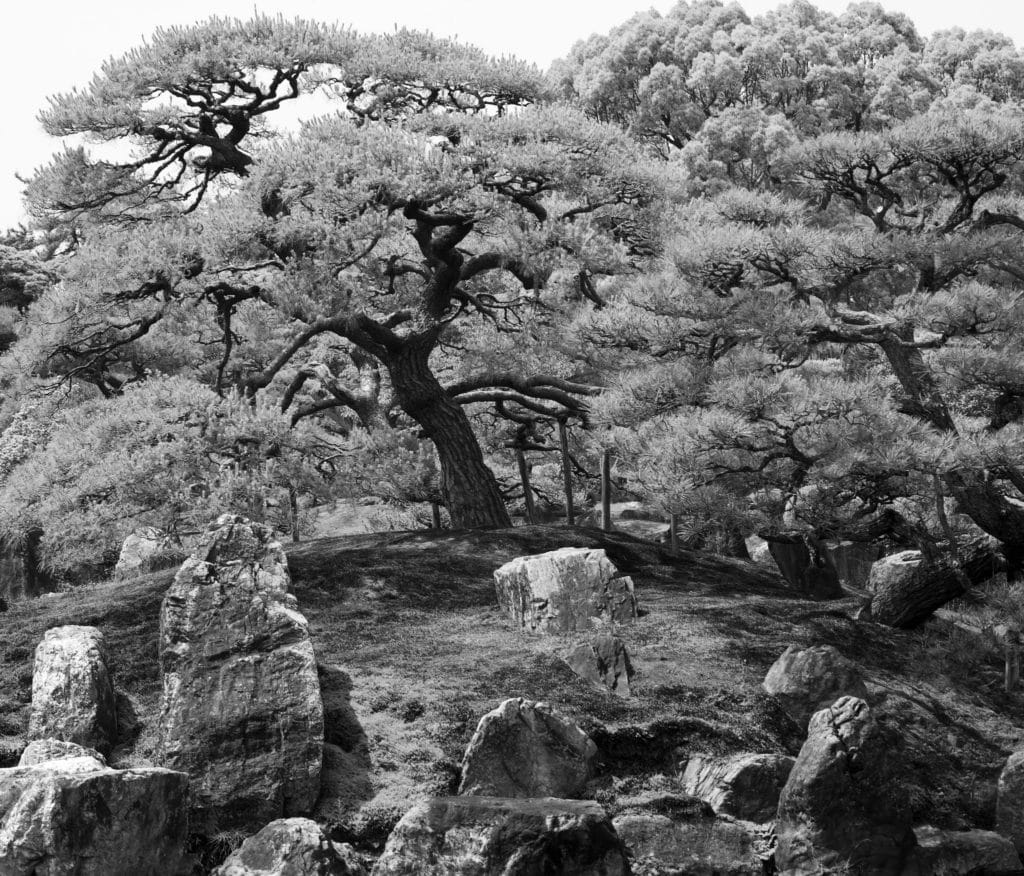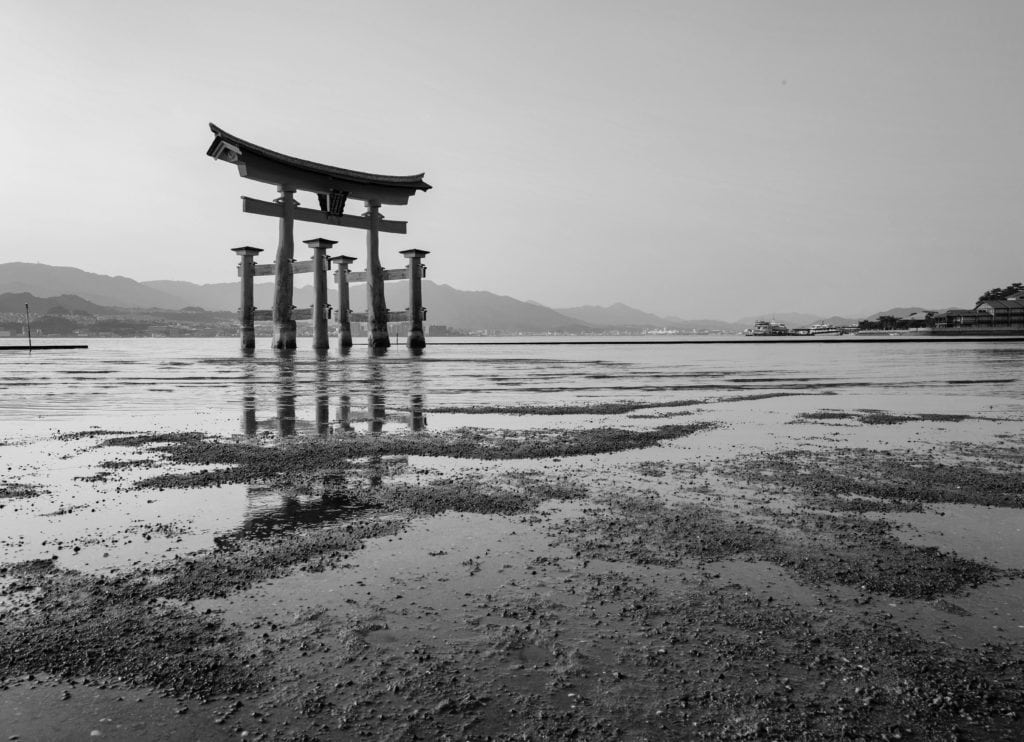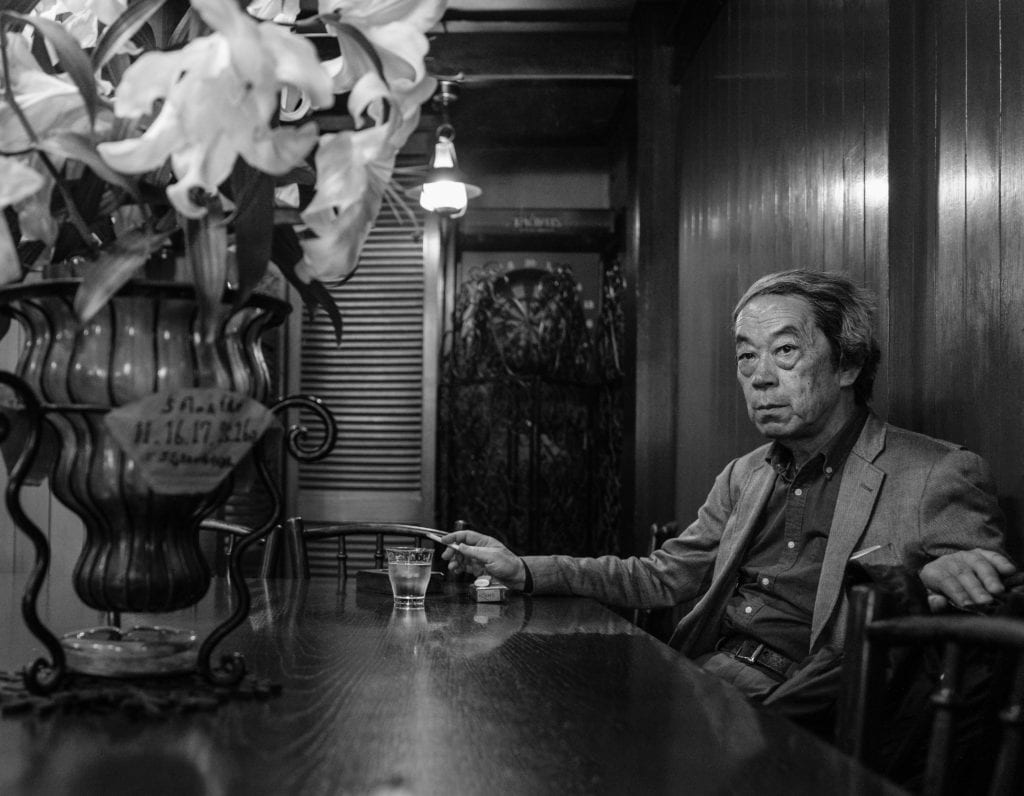
Between 13th and 23rd May 2017, I travelled across Japan with a small group of friends on a trip organised by Trailfinders. I have wanted to go for more than a decade and my expectations were sky high, and I am happy to say I wasn’t disappointed. I wasn’t sure what lenses to take with me, so I took both my Leica Q and the Nikon Df with 20mm, 35mm and 85mm fast primes. I ending up using the Leica Q (28mm) and the Nikon Df with the 85mm fitted almost exclusively, both slung across my chest in readiness. You can see the gallery here. This was our itinerary:
Day 1 – Arrival in Tokyo
We flew from London to Tokyo on British Airways. Given the time difference we arrived with time to spare on our first day, which gave us the opportunity to explore the area around the excellent Park Hotel in Shiodome, our base in the metropolis. Shiodome is close to the Ginza District, the upmarket shopping area of Tokyo, so had a short walk around the area and a lunchtime beer at the Ginza Lion Beer Hall with an accompaniment of delicious hoho-niku (tuna cheeks). We noticed the displays of plastic food (sampuru) outside the beer hall, which seem to be ubiquitous in Japan. None of us had slept well on the flight and our rooms had not been ready on arrival, so we headed back to the hotel to clean up and rest. On the way back we came across Hakuhninkan Toy Park, which introduced us to the mad world of Japanese toys and collectables. That evening we ate at Tsukada Nojo which was most notable for moromi-miso; a chunky condiment made from miso served with raw vegetables, of which we could not get enough.
Day 2 – Tokyo
- On our first full day in Tokyo we were accompanied by our guide Akiko, who was very knowledgable and helpful. We headed for the Meiji Shrine (Meiji Jingū), in Shibuya, a Shinto shrine dedicated to the Emperor Meiji and his wife. Entering through an enormous Torii gate (made from a 1,500 year old tree) we passed into a large forested area which covers 175 acres and consists of around 120,000 trees of 365 different species from all over Japan. It is both tranquil and beautiful. There is also a huge decorative display of sake barrels (kazaridaru) in the grounds, which relates to the offering of sake every year to the deities at Meiji Jingu Shrine. As we walked though the three Torii gates, Akiko told us that we should not walk through the centre line of the gate. This is called the Sei-Chu and is the area designated for the enshrined gods to pass through.
- Being British and in need of a restorative cup of tea we stopped at a Cat Cafe located near the entrance to the Shrine. Japan holds the record for the most cat cafés in the world, with as many as 39 in Tokyo. I took a bit of a risk entering the place – I am asthmatic and allergic to cats, which is not a great combination, but observed the rather bizarre spectacle without consequences.
- Next was Takeshita Street or Takeshita-dōri, a shopping street in Harajuku, which was packed with fashion concious teenagers, followed by Omotesandō, an upmarket tree-lined avenue, once the official approach to Meiji-jingū. These days it is a fashionable and architecturally notable shopping strip.
- After a spot of excellent sushi we moved on to Sensō-ji, an ancient Buddhist temple located in Asakusa. The temple is dedicated to Guanyin, the Buddhist Goddess of Mercy, and is one of the most widely visited spiritual sites in the world. We approached it though the spectacular Thunder Gate, and a walk down the wonderful Nakamise Shopping Street. I found a gorgeous picture of the Thunder Gate in one of the stalls, which I was keen to buy, but the price tag was far out of reach as it was an original. Prints will, the vendor, told me be available in about 30 years. Not far from the temple we came across a small park with the most spectacular collection of koi we had ever seen.
- We moved on to Kappabashi, or Kitchen Town and visited the Kamata knife shop. I enjoy cooking, and love Japanese steel, so I purchased a very beautiful chef’s knife made by Ryusen.
- We returned to the hotel via a cruise of the Sumida river and ate in the hotel, quite worn out.
Day 3 – Tokyo
- The Tsukuji fish market is the biggest wholesale fish and seafood market in the world and is located within walking distance of Shiodome, between the Sumida River and Ginza. Visiting it involves making a choice of either arriving at 3 AM to queue to see the tuna market open at 5 AM, or arriving by 10 AM to see market wind down. We chose the latter. The market handles more than 400 different types of seafood (many of which look like nothing on earth) and the place is a whirr of activity – most notably the ‘Turret Trucks’, which are extremely hazardous to the unwary. Whilst we missed the tuna market, we did see tuna being carved with extremely long knives, variously called called oroshi-hōchō, maguro-bōchō, or hanchō-hōchō.
- We took the tube to Shibuya Crossing, considered a must see for many visitors, and located outside the Hachiko exit of Shibuya Station. This exit is named after a famous dog, whose statue has become a popular meeting place. Shibuya Crossing effectively is a crossing point at the meeting of five roads in one of the busiest parts of the most populous city in the world, and the spectacle of up to 1,000 people crossing the road concurrently is quite astonishing.
- I was keen to visit a guitar shop in Japan, particularly as Fender Japan are noted for being quite innovative. G’Club, Shibuya did not disappoint and I purchased a low cost, light weight Japan-only Fender Telecaster that plays extremely well.
- That evening we took in Akihabar (or Electic Town), which is famous for its many electronics shops, its otaku (diehard fan) culture, and many anime/managa shops before exploring East Shinjuku/Kabukichu, in all its neon splendour. It is a red light district and supposed to be somewhat edgy, but we were so mesmerised by the neon lights, if there was any menace there it passed us by. We were not tempted to enter any of the establishments that beckoned us.
Day 4 Hakone

- Sending our luggage (sans my Telecaster) ahead to Hiroshima, we took the bullet train (Shinkansen) to Hakone, part of the Fuji-Hakone-Izu National Park and less than 100 km from Tokyo. This takes no time at all on the Shinkansen. Hakone is a popular tourist destination for the Japanese and is famous for the view of nearby Mount Fuji, though it is by no means always visible due to cloud.
- We checked into our ryokan (a traditional Japanese inn) Aura Tachibana, which offers a traditional experience but with the option of beds rather than futons. Ryokans are the oldest forms of hotels in the world with the oldest existing examples dating back to the 8th century. When we arrived the staff were very keen to ensure we were punctual for dinner, apparently this is to ensure that the food is enjoyed at the right temperature.
- Taking the bus from our ryokan in Hakone-Yumoto to Moto-Hakone, we negotiated some of the tightest hairpins I have ever see. The town has has a rather bizarre David Lynch feeling to it. There we boarded a rather improbable replica of a British Man of War and sailed on a somewhat pointless voyage across Lake Ashinoko, formed in the caldera of Mount Hakone after the volcano’s last eruption. We fortified ourselves with ‘ship’s tack’, which were actually fairly decent chocolate biscuits with pictures of Mount Fuji on them. This was the only view we had of the great mountain as the original was shrouded in cloud and completely invisible. We had steeled ourselves for this possibility and did our best not to be overly disappointed.
- Leaving our vessel, we walked to the Hakone Shrine (Hakone Jinja), which stands at the foot of Mount Hakone along the shores of the lake. The shrine buildings themselves are some way into the forest, but not at all hard to find because of the huge torii gates that provide an entrance. There is an extraordinary 9-Headed-Dragon Chōzuya (purification basin) at the shrine, with holy water pouring from each head. I was fascinated with this and spent a lot of time photographing it.
- Next we took the Hakone Ropeway to take in views of the active sulphur vents and hot springs of the Owakudani Valley (Great Boiling Valley) where black eggs (kuro-tamago) are made. The eggs are regular chicken eggs; the shells turns black when boiled in the hot sulfur spring. Eating them is said to prolong longevity. As we returned down the ropeway we passed the Ninja Cafe Fuma, where a smiling ninja, waved enthusiastically at the carriages. We had a coffee in a small airstream caravan afterwards, where we discussed the quality of our host’s brew and the black eggs for which the valley is famous. It was a faintly surreal experience, but very pleasant.
- We returned to our ryokan with its ofuro (communal baths, fed from onsen hot springs) which we shunned and yucata (a light summer kimono) which we wore for dinner. The ryokan experience was excellent, even if the food offered there, known as kaiseki and consisting of a number of small, varied dishes was quite mysterious, bordering on the inexplicable.
Day 5 Hakone to Hiroshima via Himeji
- We took the Shinkansen to Himeji, some 576 km by road from Tokyo. There we visited Himeji Castle, also known as White Heron Castle (Shirasagijo), widely considered to be Japan’s most spectacular castle and one of the country’s 12 original castles, surviving the bombing of the town in 1945. Himeji lies on a strategic point along the western approach to the former capital, Kyoto and is 3 hours from Tokyo, 1 hour and 30 minutes from Nagoya (where we changed trains) and 1 hour from Hiroshima on the Japan Rail Shinkansen. The castle is a short walk from the railway station and is in view almost immediately. The castle complex comprises a network of 83 buildings such as storehouses, gates, corridors, and turrets (yagura). There is also a moat. We enjoyed exploring the castle and I think our visit was the first time a Fender Telecaster has been taken up to the top floor. That evening we then took the train on to Hiroshima and checked into the Sheraton there, which was the only hotel that disappointed on the trip.
- Outside a small shop in Himeji we came across the strange world of Gashapon and Gacha Gacha machines. These are coin-operated vending machines that dispense high quality collectables and toys in capsules. They are often seen outside supermarkets, though you can find shops that are entirely dedicated to Gacha Gacha machines. Being in Himeji, the capsules contained small, high quality models of Samurai – some painted and some unpainted, which we were most taken with.
Day 6 Hiroshima
- We took the street car to the Peace Memorial (Genbaku Dōmu) in the Hiroshima Peace Park. It is the ruin of an exhibition building built in 1915, and the only structure left standing on ground zero. It serves as a memorial to the dead of the atomic bombing in August 1945. The peaceful, leafy setting, with many mature trees, defies the predictions that nothing would grow for 75 years after the atomic event. We were approached by several school children on their Hiroshima peace study trips, who asked us where we were from and had us show them on their maps sign their books. We also met an in vitro survivor. It was a very moving experience.
- Close to Hiroshima is Itsukushima (also known as Miyajima), the island of gods, set in the Seto inland sea, where, after a short ferry trip, we were greeted by the deer that roam the island. There is a famous shrine just a short stroll up the the beach which is built over water and has a huge orange Otorii gate on the water. It is a truly amazing sight on a very beautiful island and one of the highlights of the trip. Taking the ropeway up the mountain, which is covered by primeval forest, there are incredible views of the islands of the inland sea. We found a bar in the port that with great food and a most convivial host and had both our lunch prior to our trip to the island and a bite to eat on our return. He waved at us as we walked up to his premises on our way back and seemed quite delighted to see us again.
- Back on the Bullet train, we headed for Kyoto.
Day 7 Kyoto

- That evening we took in Pontocho and Kiyamachi, areas well known for bars, restaurants and nightlife. Though there are many traditional restaurants there, we ended up eating in Karamenya-Masumoto, which is a ramen bar that offers to dish out the chilli on a scale from 1-25. None of us braved beyond 11.
- Our first destination the afternoon we arrived in Kyoto was Gion – the famous geisha quarter on the eastern bank of the Kamo-gawa river, with its traditional wooden machiya houses. There we came across Kennin-ji a historic Zen Buddhist temple considered to be one of the so-called Kyoto Gozan or “five most important Zen temples of Kyoto”. Kenninji was founded in 1202 by the monk Eisai, who also brought tea and Zen Buddhism to Japan from China. I was hugely excited to see the the “Twin Dragons”, painted in 2002 by contemporary artist Koizumi Junsaku to commemorate the 800th anniversary of the temple’s founding and covering 175 square meters rather than the usual circle in the centre of the ceiling. This was at the bidding of the abbot of Kennin-ji who requested that the artist make dragons “rampage across the ceiling”. The painting took the artist just under two years to complete.
Day 8 Kyoto
- As in Tokyo, we had a guide for our first day in Kyoto, who introduced herself to us as Daisy. She took us to Nijo Castle, built in 1603 as the residence of Tokugawa Ieyasu, the first shogun of the Edo Period (1603-1867). The buildings are considered to be the best examples of feudal Japan’s castle palace architecture, and are a world heritage site. The grounds contain a very attractive traditional garden with a large pond, ornamental stones and pine trees.
- From there we took in the famed ‘Golden Pavilion’ (Kinkaku-ji), a Zen temple in northern Kyoto, and one of Japan’s best-known sights. The top two stories are covered in gold leaf, and cast beautiful reflections in the pond in front of it. A heron completed the view.
- We went on to the Zen temple garden at Ryoanji, (Ryōan-ji, which means the temple of the dragon at peace). It is the site of Japan’s most famous rock garden, a karesansui (dry landscape), that contains large rock formations arranged amongst smooth pebbles raked into patterns that facilitate meditation. It impressed me far more than my fellow travellers.
- We had lunch in a conveyor sushi place called Kura Sushi, which was full of locals and is far better than the conveyor sushi places we have in Europe. Whilst the conveyor offers a constant flow of dishes, there is also a touch to screen to order from, which is how most of the customers seemed to select their food.
- Finally we went to Fushimi Inari This shrine was dedicated to the god of rice and sake by the Hata clan in the 8th century and is the head shrine for some 40,000 Inari shrines across Japan. As such it is one of the most popular shrines in Japan. It is the spiritual home of the Torii and the stone fox, dressed in a red cape. A pathway lined with many thousands Torii painted bright shurio leads 4km up the mountain. En route to the top there were five Shrines and dozens of sub-shrines. Our guide told us that only a few of the many groups she had accompanied had ventured all the way up – it is a fairly punishing walk in the heat, but a very rewarding experience, and quite unforgettable.
- We ate at Ganko Takasegawa Nijoen that evening, which was an excellent traditional restaurant with a beautiful garden.
Day 9 Kyoto

- Our last day was spent relaxing after so much sightseeing. We visited the Kyoto Kyoto Aquarium, which is worth visiting for the section that recreates the aquatic environment of rivers in Kyoto and contains Japanese giant salamander. Outside the museum the Gashapon machines were matched to the aquatic experience and dispensed various denizens of the deep. After that we went back to Fushimi Inari, not to the shrine but to the bars and tourist shops. We sat in a convivial hostelry and reflected on what a fantastic trip it had been over a beer or two.
Day 10 Return to London
- Our return trip was from Osaka to Tokyo and then on to London by air, which was long but uneventful. Looking back, we should have taken the Shinkansen instead – it would taken no longer and would have made for a better journey. This is a minor point on what was a logistically flawless trip.